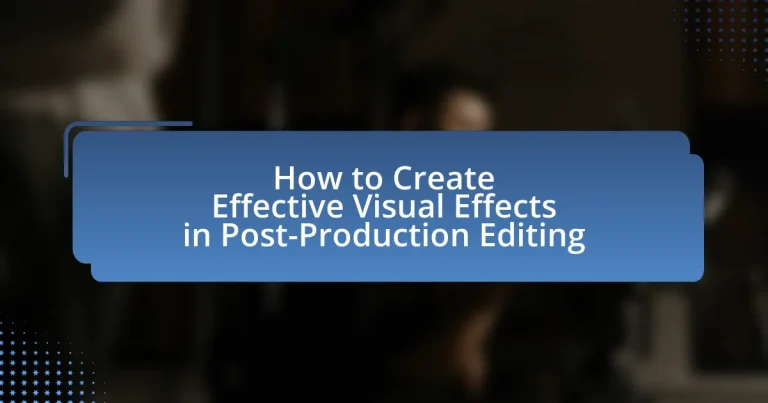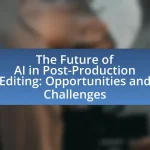The article focuses on the creation of effective visual effects in post-production editing, emphasizing the importance of digital techniques such as CGI, compositing, and motion graphics in enhancing visual storytelling. It outlines how visual effects contribute to audience engagement by creating immersive experiences and supporting narrative elements. Key topics include the types of visual effects commonly used, the role of post-production editing in integrating these effects, the impact of timing and tools on quality, and the latest trends and innovations shaping the future of visual effects. Additionally, it addresses common challenges faced in the process and offers best practices for troubleshooting and planning visual effects effectively.

What are Visual Effects in Post-Production Editing?
Visual effects in post-production editing refer to the digital techniques used to create or manipulate imagery that cannot be captured during live-action filming. These effects enhance the visual storytelling by adding elements such as computer-generated imagery (CGI), compositing, and motion graphics. For instance, films like “Avatar” and “The Avengers” utilize advanced visual effects to create immersive worlds and characters that enhance the narrative. The integration of visual effects is crucial in modern filmmaking, as it allows for the realization of creative visions that would be impossible or impractical to achieve through traditional filming methods.
How do Visual Effects enhance storytelling in films?
Visual effects enhance storytelling in films by creating immersive environments and visual elements that support the narrative. These effects allow filmmakers to depict scenes that would be impossible or impractical to film in reality, such as fantastical worlds or complex action sequences. For instance, films like “Avatar” utilized groundbreaking visual effects to transport audiences to the alien planet of Pandora, effectively deepening emotional engagement with the story. Additionally, visual effects can emphasize themes and character emotions, as seen in “Inception,” where the manipulation of reality visually represents the characters’ psychological states. This integration of visual effects into storytelling not only captivates viewers but also enriches the overall cinematic experience.
What types of Visual Effects are commonly used in post-production?
Common types of visual effects used in post-production include CGI (computer-generated imagery), compositing, motion tracking, and color grading. CGI allows for the creation of realistic or fantastical elements that are integrated into live-action footage, enhancing the visual storytelling. Compositing involves layering multiple images or video clips to create a single cohesive scene, often used to blend live-action with CGI. Motion tracking enables the integration of visual effects with moving elements in a scene, ensuring that effects follow the action accurately. Color grading adjusts the color and tone of footage to achieve a desired aesthetic or mood, significantly impacting the overall look of the film. These techniques are essential in modern filmmaking, as they enhance visual narratives and create immersive experiences for audiences.
How do Visual Effects contribute to audience engagement?
Visual effects significantly enhance audience engagement by creating immersive experiences that captivate viewers’ attention. These effects allow filmmakers to visualize complex narratives and fantastical elements that would be impossible or impractical to achieve through traditional filming methods. For instance, a study by the Visual Effects Society found that films with high-quality visual effects often see increased box office performance, as audiences are drawn to the spectacle and innovation presented on screen. This engagement is further supported by the emotional responses elicited through stunning visuals, which can deepen the viewer’s connection to the story and characters.
Why is Post-Production Editing crucial for Visual Effects?
Post-Production Editing is crucial for Visual Effects because it allows for the integration and refinement of digital elements within live-action footage. This process ensures that visual effects are seamlessly blended with the original material, enhancing the overall visual narrative. For instance, according to a study by the Visual Effects Society, 80% of visual effects work occurs in post-production, highlighting its significance in achieving high-quality results. Additionally, post-production editing enables color correction, compositing, and motion tracking, which are essential for creating realistic and immersive visual experiences.
What role does timing play in the effectiveness of Visual Effects?
Timing is crucial in the effectiveness of visual effects as it determines how seamlessly these effects integrate with the live-action footage. Proper timing ensures that visual effects align with the pacing of the scene, enhancing realism and emotional impact. For instance, in action sequences, effects like explosions or character movements must occur at precise moments to maintain viewer immersion; if they are poorly timed, they can disrupt the narrative flow and diminish the overall experience. Studies in film editing emphasize that well-timed visual effects can elevate storytelling by creating a more cohesive and engaging visual narrative, thereby validating the importance of timing in post-production editing.
How does the editing process influence the final look of Visual Effects?
The editing process significantly influences the final look of visual effects by determining how seamlessly these effects integrate with live-action footage. During editing, decisions regarding timing, pacing, and transitions directly affect the visual coherence and overall aesthetic of the final product. For instance, precise cuts and transitions can enhance the realism of visual effects, making them appear more natural within the scene. Additionally, color grading applied during editing can unify the visual style, ensuring that the effects match the lighting and mood of the surrounding footage. This integration is crucial, as studies have shown that well-edited visual effects can enhance audience immersion and emotional engagement, thereby validating the importance of the editing process in achieving high-quality visual outcomes.
What tools and software are essential for creating Visual Effects?
The essential tools and software for creating visual effects include Adobe After Effects, Autodesk Maya, Nuke, and Blender. Adobe After Effects is widely used for motion graphics and compositing, allowing artists to create intricate animations and visual effects. Autodesk Maya is a powerful 3D modeling and animation software that is crucial for creating detailed 3D assets and simulations. Nuke is a node-based compositing software that excels in high-end visual effects production, providing advanced tools for color correction and image manipulation. Blender is an open-source 3D creation suite that offers modeling, animation, and rendering capabilities, making it a versatile choice for visual effects artists. These tools are industry standards, widely adopted in film and television production for their robust features and capabilities.
Which software programs are industry standards for Visual Effects?
The industry standards for Visual Effects include software programs such as Adobe After Effects, Autodesk Maya, Nuke by Foundry, and Houdini by SideFX. Adobe After Effects is widely used for motion graphics and compositing, while Autodesk Maya is known for its 3D modeling and animation capabilities. Nuke is a powerful node-based compositing tool favored for its flexibility in high-end visual effects production, and Houdini is recognized for its advanced simulation and procedural generation features. These programs are integral to the workflows of major film and television studios, as evidenced by their frequent use in award-winning projects and their presence in industry-standard training programs.
How do different tools impact the quality of Visual Effects?
Different tools significantly impact the quality of Visual Effects by providing varying levels of precision, flexibility, and capabilities. High-end software like Autodesk Maya and Adobe After Effects allows for intricate modeling, animation, and compositing, which enhances the realism and detail of visual effects. For instance, Maya’s advanced rendering engine can produce photorealistic images, while After Effects offers extensive plugins that can enhance motion graphics and visual storytelling. Conversely, lower-tier tools may lack these advanced features, resulting in less polished effects. Studies have shown that the choice of tools can directly correlate with the final output quality, as seen in the film industry where productions using top-tier software consistently achieve higher visual fidelity compared to those using basic tools.
How can one effectively plan for Visual Effects in post-production?
To effectively plan for Visual Effects in post-production, one must establish a clear vision and detailed pre-visualization of the desired effects. This involves creating storyboards or animatics that outline each visual effect’s placement and timing, ensuring alignment with the overall narrative. Additionally, maintaining open communication between the director, VFX supervisor, and post-production team is crucial for addressing technical requirements and constraints early in the process. Research indicates that projects with thorough pre-visualization and collaborative planning experience a 30% reduction in post-production time, as confirmed by industry studies such as the “Impact of Pre-Visualization on Film Production” by the Visual Effects Society.
What are the common challenges faced in creating Visual Effects?
Common challenges faced in creating Visual Effects include managing complex software, ensuring realistic integration with live-action footage, and maintaining high-quality rendering standards. The complexity of software like Autodesk Maya or Adobe After Effects can lead to steep learning curves, making it difficult for artists to achieve desired results efficiently. Additionally, integrating visual effects seamlessly with live-action footage requires precise tracking and matching of lighting and shadows, which can be technically demanding. High-quality rendering is essential for visual effects to appear realistic, but it often requires significant computational resources and time, leading to potential delays in production schedules. These challenges highlight the intricate balance of technical skill, artistic vision, and resource management necessary in the visual effects industry.
How can these challenges be overcome during the editing process?
Challenges in the editing process can be overcome by implementing a structured workflow and utilizing advanced editing software. A structured workflow ensures that each stage of editing is clearly defined, allowing editors to focus on specific tasks without becoming overwhelmed. Advanced editing software, such as Adobe After Effects or DaVinci Resolve, provides tools that streamline the integration of visual effects, enabling precise adjustments and real-time previews. Additionally, regular communication among team members can address issues promptly, ensuring that creative visions align and technical problems are resolved efficiently.
What are the best practices for troubleshooting Visual Effects issues?
The best practices for troubleshooting Visual Effects issues include systematically isolating the problem, verifying software settings, and checking hardware performance. Isolating the problem involves recreating the issue in a controlled environment to determine its source. Verifying software settings ensures that all parameters are correctly configured, as incorrect settings can lead to unexpected results. Checking hardware performance is crucial, as inadequate resources can cause rendering issues or crashes. Additionally, reviewing logs and error messages can provide insights into specific problems, allowing for targeted solutions. These practices are supported by industry standards, which emphasize a methodical approach to problem-solving in visual effects production.
What are the latest trends in Visual Effects for post-production?
The latest trends in Visual Effects for post-production include the increased use of real-time rendering technologies, AI-driven effects, and virtual production techniques. Real-time rendering, exemplified by engines like Unreal Engine, allows for immediate feedback and adjustments, streamlining the workflow. AI-driven effects, such as deep learning algorithms for image enhancement and automated rotoscoping, significantly reduce manual labor and improve efficiency. Virtual production, which integrates live-action footage with digital environments in real-time, has gained traction, particularly in projects like “The Mandalorian,” showcasing its ability to create immersive settings. These trends reflect a shift towards more efficient, innovative, and visually stunning post-production processes.
How is technology shaping the future of Visual Effects?
Technology is significantly shaping the future of Visual Effects (VFX) by enhancing realism and efficiency through advanced tools and techniques. Innovations such as real-time rendering, artificial intelligence, and machine learning are streamlining the VFX production process, allowing artists to create more complex and visually stunning effects in less time. For instance, the use of AI-driven algorithms can automate tedious tasks like rotoscoping, which traditionally required extensive manual labor, thereby increasing productivity and reducing costs. Additionally, technologies like virtual reality (VR) and augmented reality (AR) are expanding the creative possibilities for VFX, enabling immersive experiences that were previously unattainable. The integration of these technologies is not only transforming the workflow but also setting new standards for visual storytelling in film and gaming.
What innovations are currently influencing Visual Effects techniques?
Current innovations influencing Visual Effects techniques include real-time rendering, machine learning, and virtual production. Real-time rendering, exemplified by engines like Unreal Engine, allows for immediate visual feedback, significantly speeding up the workflow. Machine learning algorithms enhance tasks such as rotoscoping and image enhancement, improving efficiency and accuracy. Virtual production techniques, utilized in projects like “The Mandalorian,” integrate live-action footage with digital environments in real-time, enabling seamless interaction between actors and CGI. These advancements collectively transform the landscape of visual effects, making them more efficient and immersive.
What tips can help in creating effective Visual Effects in post-production?
To create effective Visual Effects in post-production, focus on planning and integrating VFX seamlessly with live-action footage. This involves thorough pre-visualization to align the effects with the narrative, ensuring that lighting and camera angles match between the VFX and the original footage. Additionally, utilizing high-quality assets and maintaining consistent color grading throughout the project enhances realism. According to a study by the Visual Effects Society, effective integration of VFX can significantly elevate the audience’s immersion and emotional response, demonstrating the importance of meticulous attention to detail in post-production processes.


